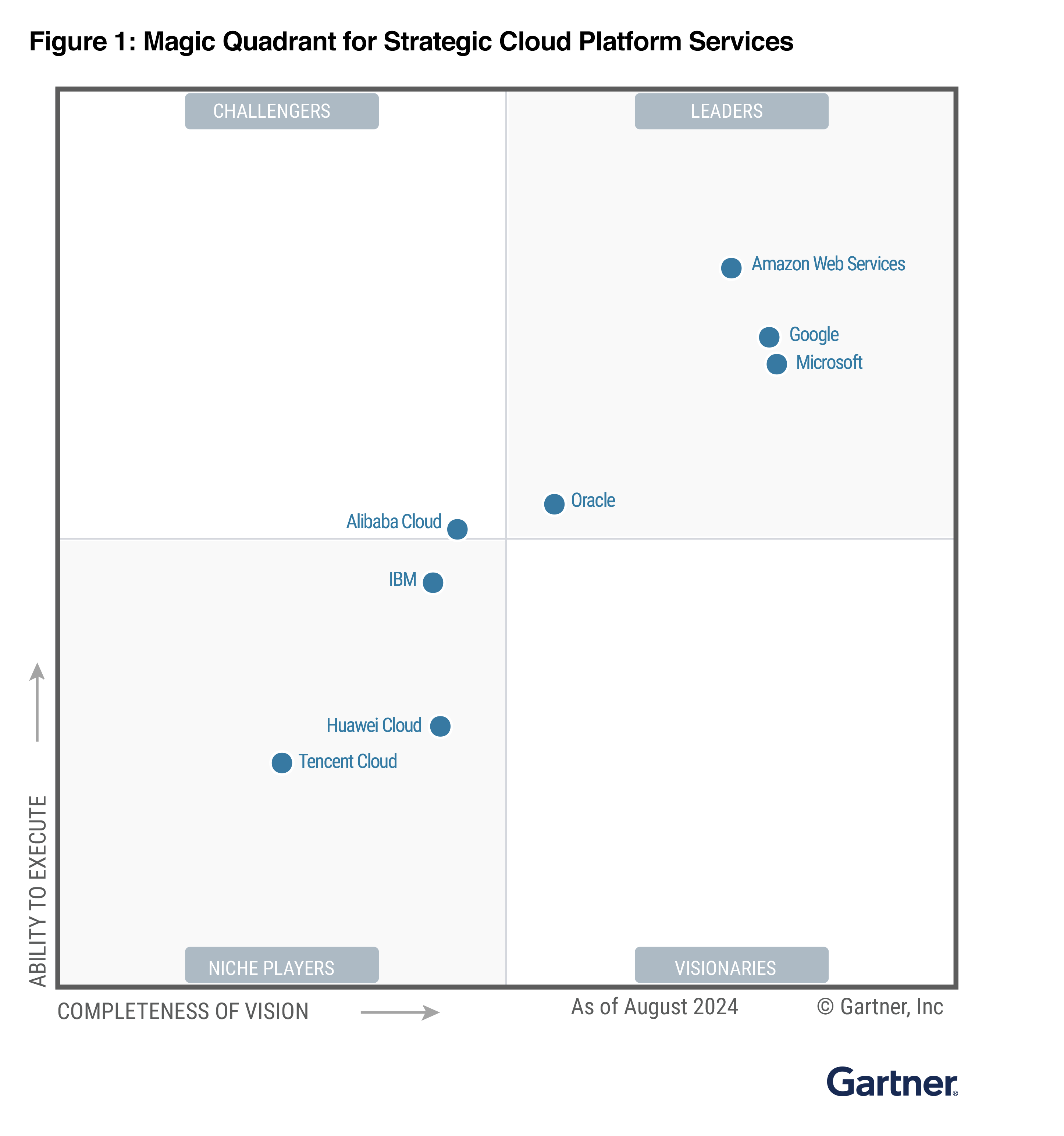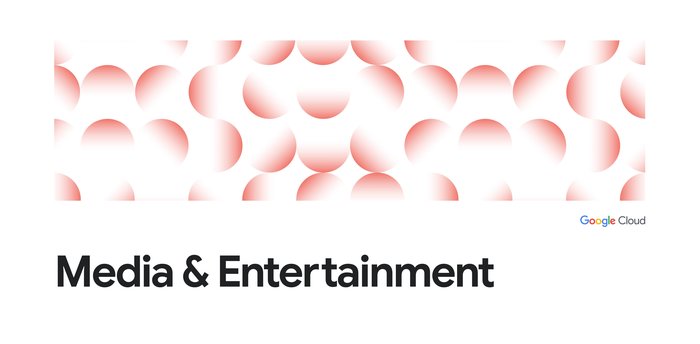Google is a Leader in Gartner Magic Quadrant for Strategic Cloud Platform Services
Brad Calder
VP & GM, Google Cloud Platform
Amin Vahdat
VP/GM, AI & Infrastructure, Google Cloud


For the seventh consecutive year, Gartner® has named Google a Leader in the Gartner Magic Quadrant™ for Strategic Cloud Platform Services. This year marks a major milestone: Google has made a notable jump in the report.
Our customers report three major advantages of working with Google Cloud infrastructure:
- A purpose-built modern cloud, specifically designed for cloud-first and AI-first apps and services.
- A workload-optimized infrastructure strategy that makes it easier to migrate and modernize traditional workloads — from SAP, VMware, Microsoft, Oracle, and even mainframes.
- Leading reliability and security among hyperscalers — customers often see Google as an extension of their security team.
But how did we enable these improvements? There are many contributors to the rapid progress of Google Cloud infrastructure, the most important of which is passionate Googlers who deeply respect the opportunity to run mission-critical infrastructure and to shape the future of cloud infrastructure. However, we would like to highlight five principles that define Google Cloud infrastructure:
1. An intentional approach: Workload-optimized computing
We realized many years ago that simply throwing more hardware at the problem of exponentially growing application performance needs is not cost-effective, and even detracts from the goals of reliability and security. We must build optimized infrastructure ‘systems’ for real-world workloads that deliver sustained performance gains despite the slowing of Moore’s Law.
We call this workload-optimized infrastructure and it is enabled in large part by Titanium, a system of next gen offloads.
Our intentional approach to infrastructure also extends to designing delightfully elegant product interfaces that prioritize simplicity and ease of use for cloud architects and administrators.
2. Powerful, sustainable AI portfolio grounded in decades of AI experience
Google is ranked #1 in AI/ML in the 2024 Gartner Critical Capabilities for Strategic Cloud Platform Services. Google has decades of experience building planet-scale AI infrastructure for its many AI-first apps and services that support billions of users across the planet. Vertex AI and Gemini bring these capabilities to Google Cloud customers. Vertex AI helps businesses turn the power of generative AI into tangible, transformative results, and allows companies to choose from the widest variety of models with first-party (Gemini, Imagen, Codey), third-party (Anthropic's Claude Model Family), and open models (Gemma, Llama 3.1). The underlying infrastructure we offer our customers is also optimized for modern AI workloads. For example, AI Hypercomputer is our optimized ‘system’ for AI/ML training and inference.
We offer the latest NVIDIA GPUs, along with six generations of purpose-built TPUs, and AI-optimized storage and networking and we strive to build the world’s most energy efficient computing infrastructure, supported by responsible water use practices and a commitment to minimizing waste. Trillium, our sixth generation of Cloud TPU, provides 4.7X increased peak compute performance per chip and 2X HBM capacity and bandwidth improvement over Cloud TPU v5e. But that’s not all; we’re also driving innovation including leading generative AI models from Google DeepMind and software frameworks such as JAX that enable developers to build apps that can run on GPU or TPU infrastructure.
3. Modern containerized computing at Google scale
Google is a Leader in Magic Quadrant for Container Management. We believe Google Kubernetes Engine (GKE) is the most scalable container service. With Google Cloud’s roots running Google’s multiple billion-user apps at very high resilience and performance, it is the best place in our opinion to build your modern applications.
Kubernetes is a popular way to run AI workloads like training, and serving large language models (LLMs), including our open model Gemma. GKE in Autopilot mode provides a fully managed Kubernetes platform that offers the power and flexibility of Kubernetes but without the need to worry about managing compute nodes, so you can focus on delivering your own business value through AI. In fact, we’ve seen a 10x year-over-year increase in the use of AI accelerators on GKE.
4. Enterprise workload readiness with leading reliability and security
From SAP to VMware to mainframes, there isn’t a major enterprise workload that can’t be moved to Google Cloud to start on its modernization journey (at your pace). Enterprise workloads thrive on Google Cloud while experiencing better performance, reliability, and security compared to alternative platforms. These enterprise applications running in Google Cloud are powered by foundational improvements in our 4th generation compute instances, such as new C4 and N4 instances, cross-cloud networking, and Hyperdisk storage, delivering clear performance and TCO advantages over alternatives.
Our digital sovereignty offerings are among the most advanced in the cloud. Google Cloud Assured Workloads helps you achieve sovereignty within Google Cloud regions. Compare that to our competitors, who often require the use of a separate cloud region to achieve similar levels of sovereignty. Also, the ability to use standard cloud regions means you don’t have to choose between supporting regulatory compliance and using the latest, most innovative cloud services.
For the most stringent sovereignty, regulatory compliance, and low-latency requirements, Google Distributed Cloud enables customers to use Google Cloud’s services (including leading open source LLMs such as Llama and Gemma) at the location of their choosing. This year, we also announced the authorization of Google Distributed Cloud air-gapped (GDC air-gapped) to host Top Secret and Secret missions for the U.S. Intelligence Community, and Top Secret missions for the Department of Defense (DoD), and the air-gapped appliance with Department of Defense (DoD) Impact Level 5 (IL5) accreditation.
5. A partner-first approach
We have made big strides in building a strong ecosystem of technology and delivery partners. Examples are our long-standing, strong partnerships with SAP, Broadcom, and NVIDIA, among many others. And most recently, our partnership with Oracle removed another blocker for enterprises to adopt Google Cloud.
Google’s approach to building an ecosystem of partners for AI/ML demonstrates how we value our partners to deliver choice and complete solutions for our customers.
Take the next steps on your journey with Google Cloud
Whether you’re running containers, experimenting with generative AI, or looking for ways to optimize your legacy apps on Google Cloud, other clouds, or at the edge, Google Cloud stands ready. We believe there is no better starting or ending point than Google Cloud for designing, deploying, and managing your services, providing a forward-looking vision of the future of cloud computing, while executing with the precision and reliability that enterprises require for their mission-critical apps.
You can download a complimentary copy of the 2024 Magic Quadrant for Strategic Cloud Platform Services on our website.
For more on our industry-leading infrastructure, please register for the Google Cloud App Dev & Infrastructure Summit on October 30th, 2024, or watch on demand. Enjoy!
Gartner, Magic Quadrant for Strategic Cloud Platform Services, David Wright, Dennis Smith, Miguel Angel Borrega, Alessandro Galimberti, Carolin Zhou, 21 October, 2024. The report was titled as Magic Quadrant for Cloud Infrastructure as a Service, Worldwide from 2018-2019 and Magic Quadrant for Cloud Infrastructure and Platform Services from 2019-2022.
GARTNER is a registered trademark and service mark of Gartner and Magic Quadrant is a registered trademark of Gartner, Inc. and/or its affiliates in the U.S. and internationally and are used herein with permission. All rights reserved. This graphic was published by Gartner, Inc. as part of a larger research document and should be evaluated in the context of the entire document. The Gartner document is available upon request from Google. Gartner does not endorse any vendor, product or service depicted in its research publications and does not advise technology users to select only those vendors with the highest ratings or other designation. Gartner research publications consist of the opinions of Gartner’s research organization and should not be construed as statements of fact. Gartner disclaims all warranties, expressed or implied, with respect to this research, including any warranties of merchantability or fitness for a particular purpose.



